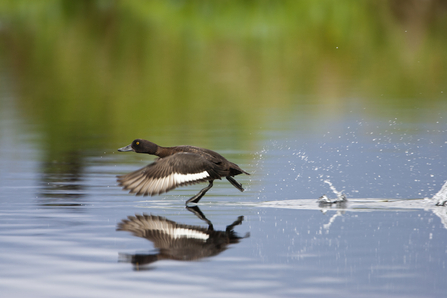
Tufted duck by Guy Edwardes
Analysis of Suffolk Wildlife Trust’s pond survey data and surveyors’ observations has reinforced the message that duck in any numbers can significantly reduce the wildlife value of a pond, especially for priority species such as great crested newt.
Ducks are part of the natural ecology of ponds, but by not encouraging them with artificial feeding and by planting duck-resistant vegetation it is possible to ensure that populations do not reach unsustainable levels and impact on wildlife.
Ponds where duck fly in on natural pond
Occasional foraging visits by a few duck should cause few problems and are part of the natural ecology of ponds. Indeed, ducks help to transport native plant seed to
different ponds. However, this can cause problems where they fly in with seeds from invasive alien pond plants such as New Zealand pygmyweed, which can then rapidly
spread, out-competing native species.
Duck are unlikely to stay on to breed in the spring at small farm ponds where no extra food is provided as there will be insufficient natural food to sustain them and
their young ducklings. Instead they would naturally move on to a larger waterbody where there is more abundant natural food.
If the pond is able to sustain them without artificial feeding, the level of duck activity is probably at a natural balance and no harm is being done to the pond and its other wildlife.
Ponds where duck are fed occasionally or regularly
Ponds supporting fed or reared duck are artificially supporting far more than they naturally could and tend to lead to visually unattractive muddy ponds devoid of plants and species-poor habitats.
Up-ending duck searching for grain and bread on the pond bottom disturb the pond substrate making the pond muddy and murky, preventing the light in the water needed for aquatic plant growth.
This problem is further exacerbated by enrichment by duck faeces and sometimes rotting food, which leads to algal blooms.
When first inhabiting a small pond, duck will initially graze pond plants, frogspawn and small invertebrates. Without pond plants, there is little food or cover for invertebrates or amphibians. As pond plants are grazed so the protection of pond edges is removed and banks become eroded and bare.
Unfortunately, in spring surrounding ponds may be adversely affected by a large population of duck concentrated on one pond, as the well-fed resident duck will move out to nearby ponds to breed (thereby impacting on them), returning for top-up feeding at the fed pond.
Managing duck numbers
Avoid encouraging large number of duck by artificial feeding. However, where they are a priority on a farm, try to keep feeding to one pond only – and that to a minimum. A no-feeding policy may be difficult to implement on village green ponds but consider discussing, at a parish level, the adverse wildlife impact on surrounding ponds.
If a pond already has a dominant population of coarse fish such as carp, try to concentrate duck activity on this pond as coarse fish will have already reduced the wildlife interest of the pond and it is better to keep both duck and fish on one pond.
On fed ponds try to establish some duck-resistant marginal vegetation such as the rhizomatous pond sedge, flag iris and reedmace which are normally quite invasive and help to protect pond margins and create small backwaters where a few invertebrates can escape.
It might also be necessary to consider a cull of duck where numbers are damaging the host and surrounding ponds.
